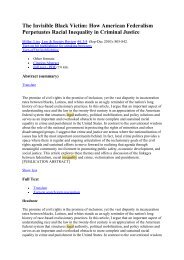Ski – resort and regional development: profile of visitors ... - E-Journal
Ski – resort and regional development: profile of visitors ... - E-Journal
Ski – resort and regional development: profile of visitors ... - E-Journal
You also want an ePaper? Increase the reach of your titles
YUMPU automatically turns print PDFs into web optimized ePapers that Google loves.
Predicting residents’ perceptions <strong>of</strong> cultural tourism attractiveness<br />
Variables in the Equation<br />
Variable B Beta t Sig. VIF<br />
(Constant) 2.285 99.919 .000<br />
Factor 2 .32 .386 14.327 .000 1.000<br />
Factor 3 .252 .295 10.975 .000 1.000<br />
Factor 4 .179 .211 7.843 .000 1.000<br />
Factor 1 .170 .200 7.413 .000 1.000<br />
Dependent Variable: Indianapolis’ attractiveness as a cultural tourism destination<br />
The regression model further indicates that the most important factor in contributing to<br />
Indianapolis’ overall attractiveness in terms <strong>of</strong> its city service items is “Leisure Services”<br />
(Beta=.386), then followed by “Hospitality Services” (Beta=.295), “Transportation Related”<br />
(Beta=.211), <strong>and</strong> “Overall Urban L<strong>and</strong>scape” (Beta=.200).<br />
Before this survey, a similar survey was conducted two years ago with a goal <strong>of</strong> predicting<br />
the dependent variable which is “Indianapolis has the potential to succeed as a cultural tourism<br />
destination” with a similar survey instrument. Interestingly, “Leisure services” turned out to<br />
be the most important dimension in the equation model, followed by “L<strong>and</strong>scape/architectural<br />
Services”, <strong>and</strong> “Hospitality Services.” Both tests show that “Leisure services” plays the most<br />
important role in determining Indianapolis’ potential or overall attractiveness as a successfully<br />
cultural tourism destination.<br />
CONCLUSIONS<br />
The economic benefits <strong>of</strong> cultural tourism are easily recognized. Its direct <strong>and</strong> indirect effects<br />
can be quite substantial, <strong>and</strong> cultural tourism can add significant diversity to a city’s economy.<br />
Cultural tourists, as a demographic group, tend to have higher incomes <strong>and</strong> are more educated<br />
than other tourists, which translates into more money spent per visit <strong>and</strong> longer stays. However,<br />
these benefits are contingent on a city’s ability to sustain the level <strong>of</strong> city services its residents<br />
<strong>and</strong> <strong>visitors</strong> are accustomed to.<br />
Decision-makers in cities <strong>of</strong> all sizes are beginning to underst<strong>and</strong> the impact <strong>of</strong> a growing<br />
cultural tourism business on their city services. A careful assessment <strong>of</strong> the situation is a way<br />
to foster urban revivals, as well as to improve the quality <strong>of</strong> the city environment <strong>and</strong> the lives<br />
<strong>of</strong> local people.<br />
Indianapolis already has diversified its tourism product. Conventions <strong>and</strong> special events are<br />
becoming more popular. Sports tourism is already well established. The emphasis is now<br />
on developing cultural tourism. Such type <strong>of</strong> tourism can have negative attributes for<br />
conservation <strong>of</strong> the city’s cultural identity <strong>and</strong> economic <strong>development</strong>. Indianapolis city <strong>and</strong><br />
Tourism Today - Fall 2007 - Full Paper<br />
135














